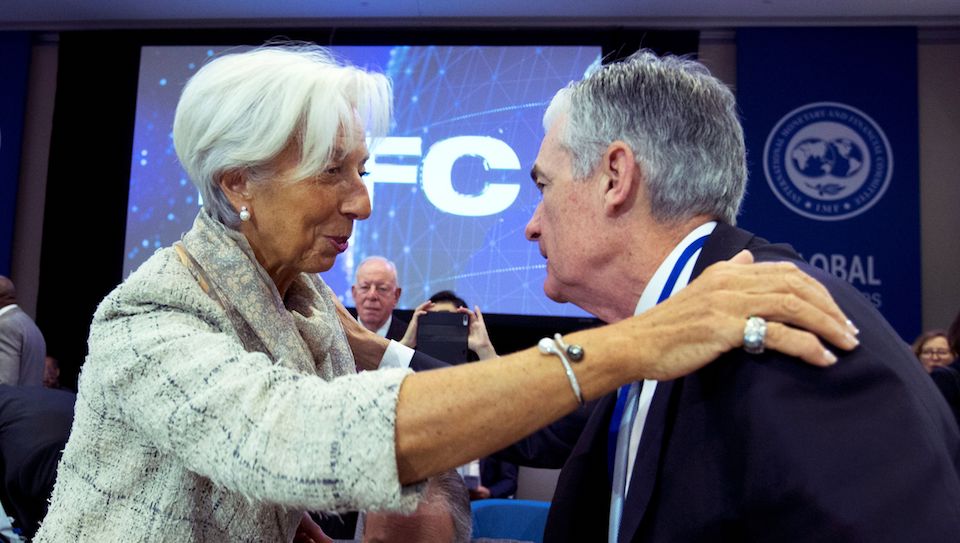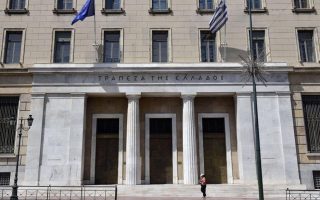Inflation: Who is right, the Fed or the ECB?

The European Central Bank remains reluctant to abandon the view that the rise in inflation is temporary, as the Fed has done in the US. It is a difference of opinion between the central banks of the US and the European Union that is generating uncertainty in the market as to who is right, over a matter that affects Greece both through the course of retail and wholesale prices and also of interest rates.
Analysts tell Kathimerini that both are, in fact, correct given their particular contexts, though the ECB is more exposed to the risk of a wrong policy in the coming months.
“Divergence in the future course of monetary policy across the Atlantic is justified, at least based on the current evidence,” says Fabio Balboni, director and senior European economist at HSBC Global Banking and Markets. He explains that while “recovery is at a more advanced phase in the US, underlying price pressures have been building up more rapidly, including in the services sector, and even more importantly the labour market dynamics are leading to bigger wage pressures.”
“So far in Europe there is limited evidence of second-round effects from currently high inflation on wages, there is more slack in the labor market and the labor market adjustment has been more gradual than in the US thanks to the short-time work schemes which should also prevent major pressures building up in the future. This should reduce the risk of a vicious cycle between wages and inflation materializing.”
Furthermore, he adds, “the ECB has to look after 19 countries, some of which are still in the early phase of the recovery and require ongoing support. This creates a dovish bias in our view (particularly considering also the relatively limited support from fiscal policy relative to the US). Because of all this, we think we will see a much later hiking cycle in the eurozone than in the US.”
“Of course, this exposes the ECB to a bigger risk of a policy mistake. If inflation tuns our to be more persistent, the ECB might find itself behind the curve and have to tighten policy quickly next year (also considering it doesn’t have a dual mandate like the Fed but only an inflation one) with likely negative consequence for growth,” says Balboni.
“The real questions are whether inflation starts declining in early 2022 and where it will settle in this new world,” notes Frederik Ducrozet, global macro strategist at Pictet Wealth Management. “I think both central banks will continue to expect inflation to ease at some point in H1 2022, and both will be right.”
He goes on to note that “there’s a difference in timing as I expect inflation in the euro area to have peaked in November, and to drop sharply in January as the German VAT effect disappear. The uncertainty relates to wage growth and the path of core inflation beyond January. The ECB will stress upside risks, but so far we haven’t seen any evidence of second-round effects on wages in Germany. If we don’t get that in Germany, chances are we don’t get second-round effects elsewhere either. So in short, if the ECB can be patient, I think they will be proven right eventually. But then the risk of a policy mistake remains high down the road.”
Differences
“Things are a bit different for the Fed. The peak in inflation would be in early 2022, and the risk is it remains sticky for longer than expected. I see two main differences relative to Europe. First, the labor market and low participation (aka Great Resignation) suggesting that wage growth could be higher than would have been otherwise, if more workers were coming back to the labour force. Second, the housing market and housing related costs represent a much higher share of the CPI/PCE indices, contributing to higher inflation even in 2022. So our conviction is lower for the US, and we now expect the Fed to speed up the taper and hike rates three times in 2022,” he says.
“Last but not least, I share the market’s concern that central banks will be constrained in their tightening process. We think the Fed can hardly hike rates to 2%, which would be our rough estimate of a neutral to tight policy stance. Call it debt dominance, or financial repression, or our inability to escape the liquidity trap for good, but I am not sure that growth will be strong enough to withstand much higher rates in the longer run,” argues Ducrozet.
Berenberg economist Salomon Fiedler says that both the Fed and the ECB “can be right about the transitoriness, in a sense: The currently very high inflation rates on both sides of the Atlantic do contain large transitory components (such as the resurgence/base effects for energy prices, supply bottlenecks, tax changes).”
“The question then is by how much inflation rates will decline once these transitory factors fall away. And here the underlying trend for inflation looks markedly higher for the US – even without the transitory factors, US inflation would be above target. Stimulus was (and is) bigger in the US. In line with this, inflation rates are also higher in the US and the Fed’s preferred measure, PCE inflation, also shows stronger dynamics.”
“Furthermore, the ECB would likely welcome it if trend inflation in the eurozone were a little higher going forward than the somewhat subdued inflation rates in the years before the crisis,” her points out.
“The Fed – even with its average inflation target – does not have this room for an upward shift of the inflation trend. It will have to tighten more quickly than the ECB, but our calls for ECB rate hikes in 2023 are also ahead of what one might get from current ECB guidance,” concludes Fiedler.
Bruegel economist Zsolt Darvas cites three factors that suggest that the ECB should be more cautious than the Federal Reserve:
“1) Fiscal stimulus was much larger in the US than in the euro area in the past two years and therefore US fiscal policy is much more inflationary than fiscal policy in the euro area.
2) Before the pandemic, inflation in the euro area was well below inflation in the US, despite massive ECB monetary stimulus. This suggests that the structural features of the euro area economy are different from the US economy and the euro area economy could be more similar to the Japanese economy, where inflation remained stuck close to zero for decades.
3) The latest core inflation indicator is 4.1% in the US (October 2021 compared to October 2020), while it is 2.6% in the euro area (November 2021 compared to November 2020). The core inflation indicator excludes volatile items like energy and food and thus better represents the underlying inflationary pressures in the economy. The 2.6% euro-area value is not much higher than the 2% inflation target of the ECB, while the 4.1% US value is more than double than the target of the Federal Reserve. Thus, the most recent actual data indeed suggest that inflationary pressure is much stronger in the US than in the euro area and therefore it is natural that the Federal Reserve starts monetary tightening earlier than the ECB.”
Darvas adds that the key question “is if wage growth will accelerate in the euro area or not, and if so, by how much. We will know more about wage developments next year: until then, a cautious approach by the ECB is justified.”
ING Senior Rates Strategist Antoine Bouvet expects the ECB to “raise rates at some point”.
He tells Kathimerini that “the situation is similar but different” in the US and the eurozone: “The Fed is dealing with an inflation problem that is much stronger and more immediate than the ECB so we think they will have to accelerate tapering and hike, possibly as soon as June. In comparison, the ECB forecasts (and we as well) that inflation will return just under the 2% target by the end of 2022. This means that it will also raise rates at some point but this is much less urgent than at the Fed.”
“Now it is worth highlighting that the ECB (and we) may be right and inflation could fail to come back down next year. If this was the case, then it would be in a similar situation as the Fed: having to unwind easing measures faster than it would like,” according to Bouvet.





